


Cassava green spider mite (Mononychellus tanajoa or M. progresivus)
This mite is green in colour at a young age turning yellowish as adult. Adult females attain a size of 0.8 mm. They appear as yellowish green specks to the naked eye. They occur on the lower surface of young leaves, green stems and auxiliary buds of cassava. Damage initially appears as yellowish "pinpricks" on the surface of young leaves.
Symptoms vary from a few chlorotic spots to complete chlorosis. These symptoms are somehow similar to African cassava mosaic disease, and should not be confused. Heavily attacked leaves are stunted and become deformed. Severe attacks cause the terminal leaves to die and drop, and the shoot tip looks like a "candle stick". Green spider mites are major pests in dry season. Severe mite attack results in 20-80 % loss in tuber yield.
Predatory mites (mainly Typhlodromalus aripo and T. manihoti) introduced from South America, the home of the cassava green mite, have given effective control of the cassava green mites in Africa (Yaninek and Hanna, 2003).
- Whenever possible, use varieties with good tolerance to green mites (Examples from West Africa: "BEN 86052", "MS6" and "NR8082") (James et al, 2000).
- Use clean plant material for planting.
- Plant at the onset of the rains to encourage vigorous growth and thereby increase tolerance to mite attack. Cassava plants aged 2-9 months are the most vulnerable to infestation.
- Practise intercropping. Cassava intercropped with pigeon pea has been reported to suffer less damage from cassava green mite than that grown on a pure stand in Nigeria. Higher tuber yields were obtained when cassava was intercropped with pigeon pea in triple and double rows than when it was alternated in a single row or in a pure stand (Ezulike and Egwuatu, 1993).
